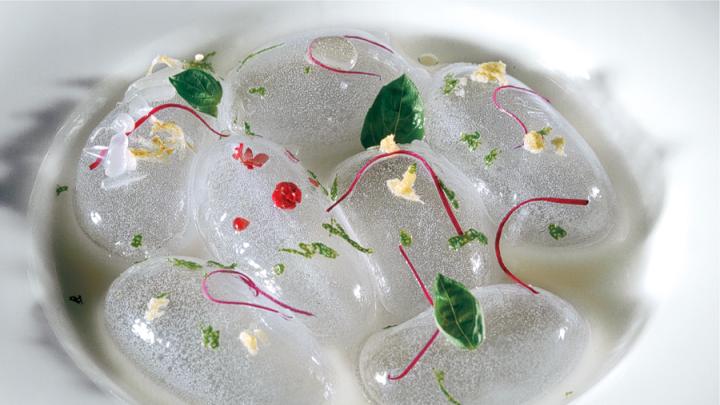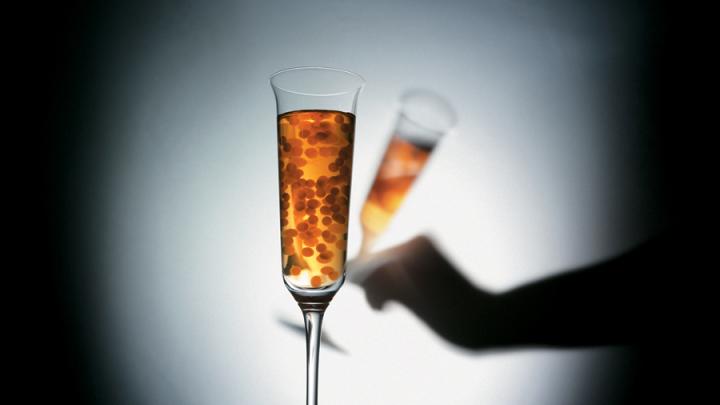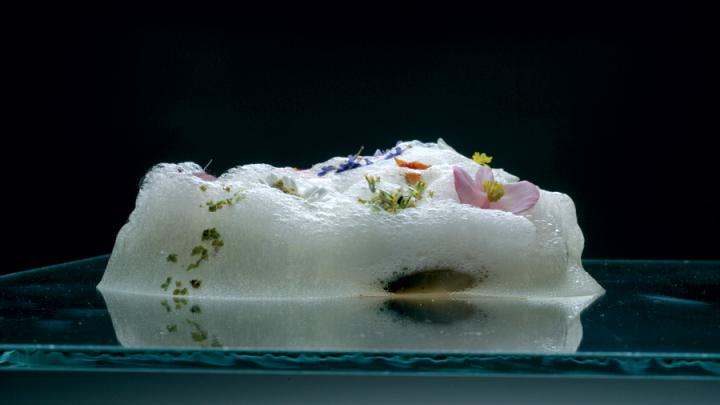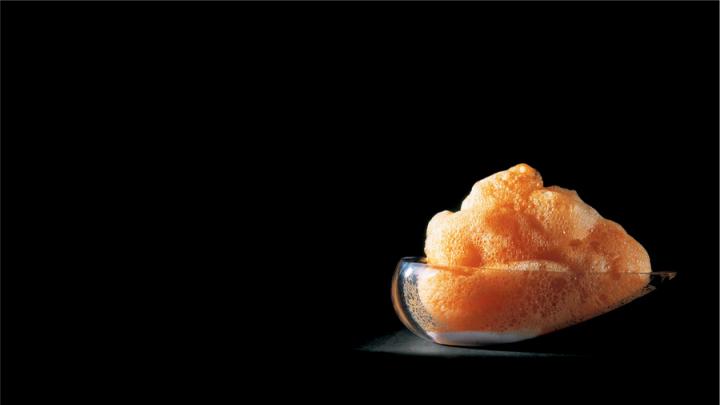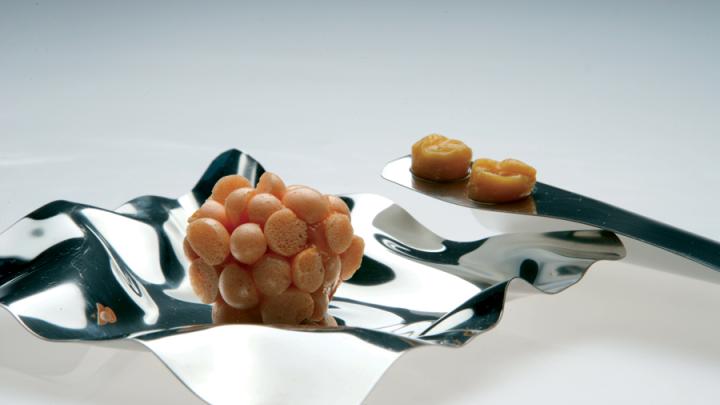Surprise is Ferran Adrià’s stock in trade. He delights the diners at elBulli, his restaurant near Barcelona, with creations such as gelatin served hot; a “bubble tea” drink in which the liquid tastes of prosciutto and the bubbles of melon; and jellybean-like objects the color and shape of a green olive—that burst in a splash of briny liquid when bitten.
These are just a few of the hundreds of playful dishes the chef has served in his nearly 25 years at elBulli (declared the world’s best by Restaurant magazine for three years running, and four times in all). Adrià’s experiments with flavor, temperature, and texture have taken him into scientists’ terrain—and his future menus may get a boost from Harvard science labs. During a visit to Cambridge in December to deliver a guest lecture and to visit some of those labs, the chef signed an agreement with professors of physics and engineering for an ongoing collaboration.
Thus far, Adrià and his staff have achieved their culinary feats through sheer trial and error; he has no formal scientific training. When a friend gave him a canister of nitrous oxide (the same propellant used in Reddi-wip) as a gift, he played around to find out what he could do with it. The result was culinary foam, perhaps Adrià’s most famous invention. (He uses substances such as beet, carrot, coconut, and honey, pureeing and then straining the liquid before aerating. The resulting foam has no egg or milk to dilute or distract from the taste of the main ingredient.) He learned about “spherification”—the use of thickeners such as alginate and calcium chloride to form these “essences” into bubbles—on an exploratory visit to a factory. Upon discovering a new technique, Adrià and his team test it across a wide variety of substances, moving from the obvious to the outlandish. (A good example is the mango anchovy ravioli foam a New York Times writer tried on a 1999 visit.)
Adrià’s invitation to Harvard came from Otger Campàs, a postdoctoral fellow in applied physics and applied math who wrote him an e-mail in Catalan (their shared native tongue) after talking with other foodie scientists about the overlap between their work and Adrià’s. Particularly in the area of soft condensed matter, says Campàs, “the connections are so obvious.” (A television news clip about Adrià’s visit noted another similarity between elBulli and Harvard: exclusivity. The restaurant’s famously opaque system books the entire year’s reservations, approximately 8,000 from a reported 2 million requests received, on a single day each October.)
From postdoctoral fellow Jiandi Wan, who works with Joseph professor of engineering and applied mathematics Howard Stone, Adrià heard about double emulsions (tiny bubbles, each inside another thin bubble, dispersed in a fluid). Emulsions—defined simply as a mixture of two unblendable liquids—are everywhere in cooking: examples include butter, cream, salad dressing, and anything else that mixes oil and water. Emilie Dressaire, a doctoral student in the same lab, showed Adrià how she combines glucose syrup and sucrose ester molecules in a KitchenAid mixer to produce a foam made of “nanopatterned cells” that hold their shape and preserve a foamy texture in the absence of fat. Dressaire thinks this technique could find an application in fat-free ice cream (see “A Durable Bubble,” November-December 2008, page 18); after poking a finger into a sample of the foam, kept in the lab refrigerator, Adrià mentioned that the elBulli kitchen had been using glucose syrup since 2005.
For Campàs, who grew up during Adrià’s ascent to godlike status and learned to cook using the chef’s books and DVDs, the whole experience has taken on a tinge of the surreal. During an interview over lunch one day in January, Campàs’s cell phone rang; when he checked to see who was calling, the name “Ferran Adrià” flashed.
Campàs visited elBulli in late January with Mallinckrodt professor of physics and applied physics David Weitz. Details of the partnership are still being solidified, but all involved hope it will include an exchange of scholars in both directions. (While in Cambridge, Adrià also gave guest lectures in an undergraduate course on innovation in engineering and a Harvard Business School course taught by assistant professor Michael Norton, who had written a case study on elBulli.)
And Adrià voiced hopes that Harvard scientists could help him better understand the principles that underlie his creations. Why is it easier to make foam from beets than from anything else he’s tried? Why do the melon “caviar” beads have a soft center at first, but congeal into dense, gummy balls if not eaten right away? Adrià said he hoped to collaborate on an encyclopedia of cooking and science that would explore these matters.
He practically salivated as he listened to descriptions of the equipment in use in Harvard science labs, including a spin coater—which uses centrifugal force to coat surfaces with an extremely thin layer of a given substance—and Jiandi Wan’s machine for creating double emulsions. And then, of course, there’s the potential that Harvard scientists could help him solve problems that still frustrate him, such as making an ice cream that can be served hot without melting.
Weitz, who directs Harvard’s Materials Research Science and Engineering Center, says one of his first priorities is getting cooking into the curriculum. He hopes to get Adrià’s input in creating not only a graduate course in soft condensed matter, focusing on food, but also a course for the new undergraduate general-education curriculum (possibly co-taught by Adrià himself). “Those of us who do science do it because it’s fun,” he says. “We want to bring real science, through cooking, to people who are not ordinarily interested in science.”
Among those who don’t consider themselves ardent Adrià fans, the chief criticism is that he engages in culinary acrobatics, concerning himself more with feats of science than with food that actually tastes good. Adrià vehemently denies this (as do most reviewers). Using nitrous oxide to make foam or a liquid-nitrogen bath to freeze liquid ingredients and mold them into shapes such as a dessert cup (a method similar to deep frying, at the opposite temperature extreme) is no different from cooking with boiling water or hot oil, he asserted during the undergraduate engineering lecture. He urged his listeners not to confuse what is complicated with what is merely new: “Cooking has always been science—physics and chemistry. When you lit a fire to cook a million years ago, you were already using science.”


